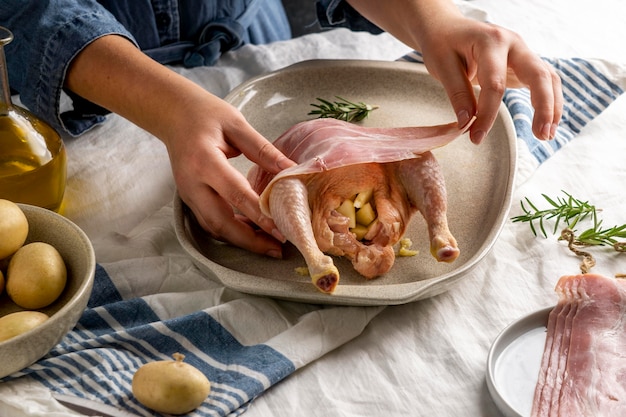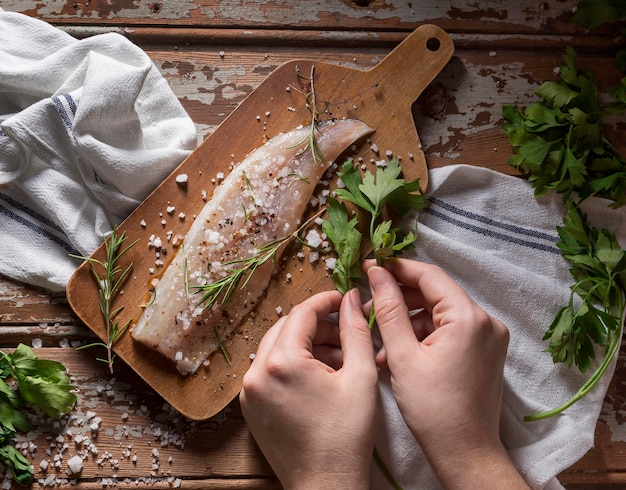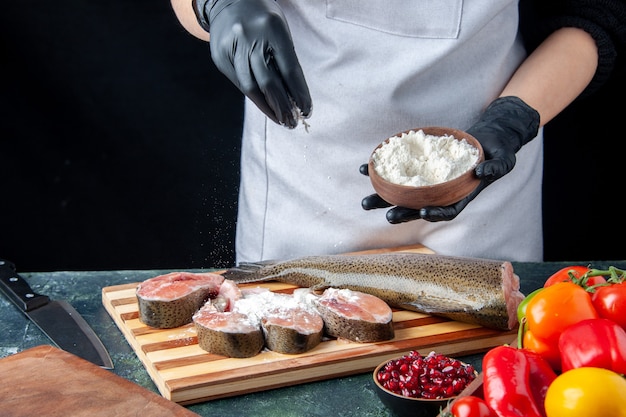(Part 1) The Foundation: Building a Flavorful Base

Choosing the Right Meat Blend
I've experimented with all sorts of ground meats - beef, pork, lamb, even chicken. But for a classic, irresistible meatloaf, a blend of ground beef and pork is the way to go. The beef provides that rich, meaty flavour, while the pork adds a touch of sweetness and juiciness that's simply divine.My personal favourite blend is a 70/30 ratio of ground beef to ground pork. But don't be afraid to experiment! Ground turkey or chicken offer a lighter option, and a touch of ground veal adds a luxurious twist. Just remember to avoid excessively lean meats, as they can lead to a dry, disappointing outcome.The Importance of Fat - Don't Be Afraid to Embrace It!
You might be thinking, "Fat? But I'm trying to be healthy!" I hear you, but trust me, fat is your friend when it comes to meatloaf. It contributes to flavour, tenderness, and keeps the meat moist and succulent. We're not talking about going overboard, but a little fat is essential for a truly delicious meatloaf.Aim for ground beef with an 80/20 or 85/15 fat-to-lean ratio. This will give you a nice balance of flavour and moisture. If you're using a leaner meat, consider adding a little extra fat, like finely diced bacon or pancetta, to the mix.Salt and Pepper: The Essential Seasoning Duo
Now, before we move on to the other ingredients, let's talk about the unsung heroes: salt and pepper. A generous pinch of each is vital for unlocking the full flavour potential of the meat. I recommend using freshly ground black pepper for the most intense flavour, but a good quality pre-ground pepper will do in a pinch (pun intended!). As for salt, remember, a little goes a long way. Season generously, but don't overdo it!(Part 2) The Binding Power: Bringing It All Together

The Classic: Breadcrumbs - A Reliable Staple
The classic binder for meatloaf is, of course, breadcrumbs. They absorb excess moisture, add a satisfying texture, and help the meatloaf maintain its shape during cooking. I prefer using fresh breadcrumbs, made from stale bread that I toast in the oven until golden brown and fragrant. But store-bought breadcrumbs will do in a pinch (there's that pun again!). Just make sure to choose fine, soft breadcrumbs, not the coarse, crunchy type.Alternative Binders - For Gluten-Free and Creative Cooks
If you're looking for a gluten-free option, oats, cornmeal, or crushed crackers make excellent substitutes for breadcrumbs. Finely grated potatoes or even crushed cereal, like Rice Krispies, can also add texture and binding power. Experiment and see what works best for you!Liquid Magic: Adding Moisture and Richness
To boost the moisture and create a richer, more luscious meatloaf, we'll add a little liquid to the mix. Milk, eggs, or even a splash of broth will do the trick. I typically use a combination of milk and an egg for a creamy, decadent flavour. But feel free to use whatever you have on hand.A Touch of Umami: Worcestershire Sauce - The Secret Weapon
And finally, for that extra layer of depth and savouriness, a touch of Worcestershire sauce is a must. It adds a complex, umami-rich flavour that balances the sweetness of other ingredients and elevates the overall taste profile.(Part 3) A Symphony of Flavors: Vegetables and Herbs

The Vegetable Ensemble - A Culinary Orchestra
I adore adding a mix of chopped vegetables to my meatloaf, like onions, celery, carrots, and even finely diced bell peppers. They bring a delightful sweetness and complexity to the flavour. I usually sauté the vegetables lightly in a little oil before adding them to the meat. This intensifies their flavour and ensures they're cooked through, preventing any raw bits from spoiling the texture.The Herb Garden - A Bouquet of Freshness
Now, for the herbs! I always add a mix of fresh herbs like parsley, thyme, rosemary, and oregano. If you don't have fresh herbs, dried herbs work just as well. Just remember to use a little less, as dried herbs are more concentrated.A Touch of Spice - Adding a Kick
Don't be afraid to add a touch of spice to your meatloaf! A pinch of cayenne pepper, chili powder, or paprika can give it a delightful kick. Just be mindful not to overdo it, especially if you're serving it to children or those who prefer milder flavours.(Part 4) Shaping the Masterpiece: Getting Ready to Bake
Now that we have our delicious meatloaf mixture ready, it's time to shape it into a culinary masterpiece. A little patience and finesse will go a long way here.The Loaf Pan - Your Meatloaf's Home
Most meatloaf recipes call for a loaf pan, and for good reason! It gives the meatloaf a nice, even shape and ensures it cooks evenly. I prefer using a 9x5 inch loaf pan; it's a perfect size for a family-sized meatloaf.Greasing the Pan - Preventing Sticking
Before you start shaping the meatloaf, give your loaf pan a good grease with butter, oil, or cooking spray. This will prevent the meatloaf from sticking to the pan, making it easier to remove once it's cooked.The Shaping Process - Gently and Evenly
Now, here's the fun part. Gently press the meat mixture into the loaf pan, smoothing it out with your hands. Make sure the mixture is evenly distributed, and the loaf has a nice, even shape. You can even add a little indentation to the top of the loaf for a classic look.The Finishing Touches - Adding a Touch of Elegance
Once the meatloaf is shaped, you can add a few finishing touches. I like to brush the top with a mixture of Dijon mustard and brown sugar for a sweet and tangy glaze. You can also sprinkle the top with breadcrumbs or chopped nuts for a crunchy topping.(Part 5) The Baking Process: Transforming Raw to Delicious
Finally, it's time to bake our beautiful meatloaf! This is where we'll transform it from a raw mixture into a delicious, golden brown masterpiece.Preheat the Oven - The Key to Even Cooking
First, preheat your oven to 350°F (175°C). This will ensure the meatloaf cooks evenly and achieves that perfect golden brown colour.Baking Time - Patience is Key
The baking time for a meatloaf will vary depending on its size and thickness. Generally, it will take about 1 hour to 1 hour and 15 minutes. However, it's essential to check for doneness with a meat thermometer. The meatloaf is done when the internal temperature reaches 160°F (71°C) for beef, or 165°F (74°C) for pork.Resting Time - Allowing the Juices to Redistribute
Once the meatloaf is cooked, let it rest for at least 10 minutes before slicing. This will allow the juices to redistribute throughout the meat, making it even more tender and flavorful.(Part 6) The Glaze: Adding a Final Touch of Magic
Now, here's where we add that extra layer of flavour and visual appeal - the glaze. It's a simple but effective way to take your meatloaf from good to great.The Classic Glaze - Ketchup, Brown Sugar, and Vinegar
A classic meatloaf glaze is made with ketchup, brown sugar, and a bit of vinegar. It's sweet, tangy, and incredibly delicious.Get Creative - Explore Different Glazes
But don't be afraid to get creative! You can try using a Dijon mustard glaze, a honey-soy glaze, or even a barbecue sauce glaze. The possibilities are endless!Glazing Techniques - Caramelized Perfection
To apply the glaze, simply brush it over the top of the meatloaf during the last 15 minutes of baking. This will allow the glaze to caramelize and create a beautiful, shiny finish.(Part 7) Serving with Style: A Feast for the Eyes and the Palate
Now, your meatloaf is ready to be served! You've put in the time, the effort, and the love, and it's time to enjoy the fruits of your labour.The Perfect Accompaniments - Enhancing the Flavour
A meatloaf is best served with a variety of accompaniments. A simple green salad, creamy mashed potatoes, or some roasted vegetables are all excellent choices.Adding a Touch of Elegance - Presenting with Flair
To make your meatloaf even more impressive, you can slice it into thick slices and arrange them on a platter. Garnish with fresh herbs, a drizzle of glaze, or a few roasted vegetables for a touch of elegance.Presentation Matters - Creating a Culinary Masterpiece
Presentation is everything! A beautifully presented meatloaf will make your guests feel like they're at a fancy restaurant. Don't be afraid to get creative and have fun with it!(Part 8) The Leftovers: A Delicious Second Act
So, you've made a beautiful meatloaf, and you've enjoyed it with your family and friends. But what about those leftovers? Don't let them go to waste! They can be transformed into even more delicious dishes.Meatloaf Sandwiches - A Classic Choice
A classic! Simply slice the leftover meatloaf and use it to make delicious sandwiches. Add some lettuce, tomato, and mayonnaise for a hearty and satisfying meal.Meatloaf Hash - A Savory Twist
Dice the leftover meatloaf and mix it with potatoes, onions, and peppers. Fry it up in a skillet with a little oil for a delicious and filling hash.Meatloaf Soup - A Hearty and Flavorful Option
Add the leftover meatloaf to a pot of soup for a hearty and flavorful meal. You can use the meatloaf in a tomato soup, a vegetable soup, or even a creamy potato soup.(Part 9) The Art of Adaptation: Creating Your Own Meatloaf Masterpiece
By now, you've learned the basic principles of making a delicious meatloaf. But remember, this is your kitchen, your creation! Don't be afraid to experiment and add your own personal touches.Experiment with Flavours - Unleash Your Creativity
Try different combinations of vegetables and herbs. Add a touch of exotic spices like cumin, coriander, or paprika. Experiment with different types of cheese, like cheddar, Swiss, or Monterey Jack. The sky's the limit!Embrace the Unexpected - Think Outside the Box
Don't be afraid to think outside the box! Add some chopped bacon, sausage, or even some cooked chicken to your meatloaf. Mix it up with some roasted peppers, sun-dried tomatoes, or even a handful of chopped olives.Let Your Creativity Shine - Make it Your Own
The beauty of cooking is that it's an art form. It's about expressing yourself and creating something beautiful and delicious. So, have fun, experiment, and don't be afraid to make mistakes. That's how you learn and grow as a cook.FAQs
1. What if my meatloaf is too dry?
If your meatloaf is too dry, you can try adding a little more liquid to the mixture next time. You can also try using a fattier ground beef or adding a little extra bacon or pancetta.
2. Can I freeze leftover meatloaf?
Absolutely! You can freeze leftover meatloaf for up to 3 months. To freeze it, wrap it tightly in plastic wrap or aluminum foil. When you’re ready to eat it, thaw it overnight in the refrigerator.
3. How can I tell if my meatloaf is done?
The best way to tell if your meatloaf is done is to use a meat thermometer. The internal temperature should reach 160°F (71°C) for beef, or 165°F (74°C) for pork.
4. What are some alternative toppings for meatloaf?
In addition to the classic ketchup glaze, you can try topping your meatloaf with Dijon mustard, brown sugar, honey-soy sauce, barbecue sauce, or a mixture of chopped nuts and breadcrumbs.
5. Can I make a vegetarian meatloaf?
Yes, you can! There are many delicious vegetarian meatloaf recipes available. You can use lentils, chickpeas, or even mushrooms as the base for your meatloaf.
Everyone is watching

Corn on the Cob: The Ultimate Guide to Perfectly Cooked Ears
Healthy MealsAh, corn on the cob. Just the name evokes images of sunny days, barbecues, and that sweet, juicy flavour that ...

Perfect Pork Roast Oven Cooking Time: A Guide to Delicious Results
Healthy MealsThere's something truly satisfying about a perfectly roasted pork. The aroma alone is enough to make your mout...

Ham Cooking Time: How Long to Bake, Smoke, or Boil a Delicious Ham
Healthy MealsAh, ham. It's a classic, isn't it? A real crowd-pleaser, especially around holidays. And when done right, it'...

Scallops: The Ultimate Guide to Perfect Cooking
Healthy MealsAh, scallops. Those delicate, sweet, and utterly delicious morsels of the sea. They hold a special place in my...

Spaghetti Squash: The Ultimate Guide to Cooking and Serving
Healthy MealsRemember that time you saw spaghetti squash at the supermarket, looking all bumpy and strange, and thought, "W...
